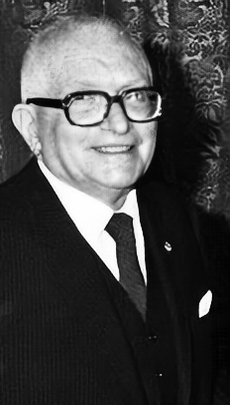Massimo Pallottino facts for kids
Massimo Pallottino (born November 9, 1909, died February 7, 1995) was an Italian archaeologist. He was a very important expert on the Etruscans. The Etruscans were an ancient people who lived in Italy before the Romans. Pallottino studied their culture and art.
Contents
Life and Work of Massimo Pallottino
Massimo Pallottino was born and lived in Rome, Italy. He became a student of a famous archaeologist named Giulio Quirino Giglioli. Early in his career, Pallottino worked on finding ancient ruins. One of his first projects was at the Temple of Apollo in a place called Veii.
Creating Etruscan Studies
Pallottino is known for creating the modern study of Etruscan culture. This field is called Etruscology. He taught many students who later became leading experts themselves. He wrote many books and articles during his career. He also helped start a research center in Rome. Today, this center is known as C.N.R. per l'Archeologia etrusco-italica.
He also helped create the Istituto Nazionale di Studi Etruschi ed Italici. This is a national institute for Etruscan and Italic studies. It publishes an important journal called Studi Etruschi. Pallottino's own work looked at Etruscan art, culture, and even their language.
Important Books and Discoveries
One of his most important books was Etruscologia. It was first published in 1942. This book is still used by students and experts today. It has been translated into many languages. Pallottino was a professor at the University of Rome, "La Sapienza".
The Etruscan Warrior Forgery
In 1937, Pallottino wrote an article about a statue. This statue was called the "Etruscan Warrior." The Metropolitan Museum of Art had bought it. Pallottino said the statue was a forgery, meaning it was fake. At first, the museum's expert, Gisela M. A. Richter, did not believe him. But later, in 1961, another scholar proved Pallottino was right.
Pallottino also wrote about Etruscan art. He showed how it was influenced by the ancient Greek world. In 1952, he wrote a book called Etruscan Painting. In 1971, his book Civiltà artistica etrusco-italica summarized much of the work in Italian archaeology.
Winning the Balzan Prize
In 1982, Pallottino won the Balzan Prize. This is a very important award. He won it for his amazing research and discoveries. These included his work at Pyrgi. At Pyrgi, he made a huge discovery. He found the Pyrgi plaques. These are ancient texts that helped experts understand the Etruscan language better. He also helped us learn more about the origins of ancient Rome.
Legacy and Influence
Massimo Pallottino passed away from a heart attack in Rome on February 7, 1995. In 1997, two books were published to honor him. They were called Etrusca et Italica: Scritti in ricordo di Massimo Pallottino. One of his most famous students was Giovanni Colonna. Colonna is now one of the top experts in Etruscology.
See also
 In Spanish: Massimo Pallottino para niños
In Spanish: Massimo Pallottino para niños


